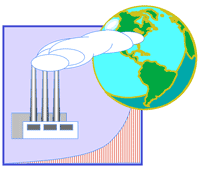
How Does Life Begin and Develop?
Goal
1
How
Life Arose on Earth
Goal
2
Organization of Matter into Living Systems
Goal
4
Coevolution of the Biosphere and the Earth
Does Life Exist Elsewhere in the Universe?
Goal
7
Signature of Life on Other Worlds
Goal
8
Life on Mars and Europa
What is Life's Future on Earth and Beyond?
Goal
9
Environmental Change on Earth
Goal
10
Terrestrial Life in Space
Question: What is Life's Future on Earth and Beyond?
Goal
9: Determine How Ecosystems Respond to Environmental Change on Time-Scales
Relevant to Human Life on Earth
 Examine
the habitability of our planet over time in the face of both natural and
human-induced environmental changes, and assess the role of rapid changes
to enable predictive models of environment-ecosystem interaction.
Examine
the habitability of our planet over time in the face of both natural and
human-induced environmental changes, and assess the role of rapid changes
to enable predictive models of environment-ecosystem interaction.
Human-induced changes on Earth -- including contamination of oceans, freshwater and soil; deforestation and desertification; exotic species invasion; ozone depletion in the stratosphere; changes in atmospheric C02 levels, and the potential for sea level rise -- are altering the adaptation and evolution of our biosphere. Research at the level of the whole biosphere is needed to examine the habitability of our planet over time in the face of both natural and human-induced environmental changes. To help assure the continuing health of this planet and to understand the potential long-term habitability for other planets we need to assess the role of rapid changes in the environment and develop our knowledge base to enable predictive models of environment-ecosystem interaction.
Background
Astrobiology will seek to understand and to predict how changes on Earth have and will alter the adaptation and evolution of our biosphere on time scales measured in units of one million years to less than one year. Rapid environmental changes on Earth associated with recent human activities include toxic contamination of oceans, freshwater and soil, deforestation and desertification, exotic species invasion, decline in ozone in the stratosphere, and large changes in atmospheric C02. To help assure the habitability of a planet for humans, we will need to develop experimental methods to detect critical biophysical and geochemical components and their interactions during the formation of new ecosystems. It will be necessary also to integrate experimental results by development of models and theory that can address indirect effects and nonlinear environmental interactions that could produce unexpected and counter-intuitive impacts on the human biosphere. This integrated research approach will seek ultimately to identify the consequences for habitability of Earth if environmental changes outpace the capacity for adaptation and evolution of natural ecosystem components. Ultimately we desire to understand a range of conditions that applies to other planets as well as the Earth, including planets that are both young and old, biologically more simple or more complex than present-day Earth. We should attempt to broaden our perspective of the planet over time to investigate the spectrum of biosphere development. Biosphere-level research is needed to define the general habitability a planet and mechanisms of bioprotection, mainly through study of the interactions of Earth's ecosystems with its atmospheric chemistry and radiation balance. This research is a natural extension of Goal 3 and Goal 4 into current times, moving from historical studies into direct observation and experiment dealing with rapid rates of change.